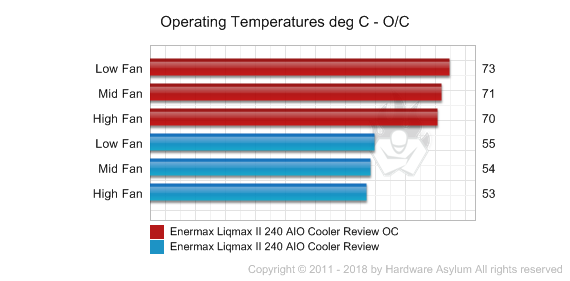Enermax Liqmax II 240 AIO Cooler Review
Author: Dennis GarciaBenchmarks
The Enermax Liqmax II 240 is designed for Intel Socket LGA2066 / 2011 / 1156 / 1155 / 1150 / 775 and AMD processors. Here is an overview of the system and testing methodology.
MSI X99A Tomahawk – X99 Chipset
Intel Core i7 5960x (3.0Ghz) Octo Core 8 x 256KB L2 Cache 20MB L3 Cache
Enermax Liqmax II 240mm x 27mm
Thermaltake Water 3.0 280mm x 27mm
The CPUID System Monitor was used to obtain and record system temperature data and being that this is a quad core processor we need something that will work across all of the cores at once. For this task we're using a new version of Prime95 (p95v255a) that will allow you to spawn (n) instances to test with.

Editors note: Even though the Windows 7 task manager reported 100% processor usage we could never attain a 100% of the rated heat output as documented by Intel (see below) when using Prime95 as a basis for that heat production. Knowing this we ran the stress test until the maximum temperature was attainted and stabilized.
Other things to consider when judging software induced heat output.
a) Clock throttling by the processor at high temperatures.
b) Normal software isn't designed to produce maximum heat output.
c) Variances of cooling temperature.
d) Variances in CPU load.
e) Inaccuracies in thermal diode readouts.
Of course the list goes on..
Our testing methodology is aimed to provide a real world look into this heatsink given the test system provided.

A C/W rating can quickly be calculated using this formula.
C/W = (CPU temp - Ambient temp)/(Variance(%) * CPU Watts)
Allowed variance for this test = 85%
CPU Watts = 140W
0.26 C/W = (54C - 22C)/(.85(140W))
For this next test the CPU speed was cranked up to 4.2Ghz and the test was re-run

To calculate a new C/W rating for this test we will need to factor in the increased processor wattage. The formula and constants for this are listed below.
ocC/W = dCPU Watts * (ocMhz / dMhz) * (ocVcore / dVcore)2
ocMhz = 4200
dMhz = 3000
ocVcore = 1.25
dVcore = 1.0
The variance still applies for our C/W calculation
Allowed variance for this test = 85%
CPU Watts = 306W
0.18 C/W = (71C - 23C)/(.85(306W))
In our heatsink and waterblock tests we don't really focus on overall load temperatures but rather how well the product can remove heat given a specified heat load. Since this is a real world testing method we need to take into consideration real world variables and estimate tolerances. This is why we normally only apply 85% of the total wattage output to our heat calculations.
The resulting C/W number is used to rate how efficient a heatsink or waterblock is based on the given heat load. These numbers can be used to determine heat capacity, the larger the difference the less efficient the heatsink is. (aka not good for overclocking)
It is not uncommon to see an increase in thermal capacity when using AIO watercoolers which is due to how much heat water can move from one location to another. This is indicated by the C/W number being lower between the tests and there are two ways to look at this. The first, and most obvious, is that you have to look at fan speed. This is something I don’t include in these reviews but I do call out that the fan is set to a SMART profile meaning that as temperatures rise so does the fan speed. At the 65c load temperature both of the fans were running at 100%. I also recorded three temperature profiles for each of the fan limits which altered load temps by about a degree each.
This cooler was showing signs of reaching its thermal capacity when you look at the low fan speed tests. The two degree difference in load temps is an indicator that it is having difficulty dissipating heat but is still well below the thermal capacity recorded at default speed. Alternatively at mid and high speeds the temperatures are on point and should carry this cooler to the claimed 350w TDP indicated on the box.
Keep in mind these calculations are provided for demonstration purposes only and may not reflect the actual lab tested C/W rating, but we're pretty close.

